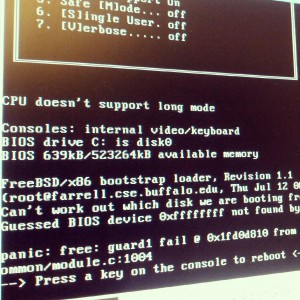Posted: February 4th, 2013 | Author: hiren | Filed under: FreeBSD, storage | Tags: CAM, FreeBSD, newbie, SATA, SCSI, storage | No Comments »
Standards in order of their creation/availability:
SCSI (Serial Computer System Interface), oldest
ATA (IDE) : AT Attachment, later became PATA (Parallel ATA)
SATA (Serial ATA) : better than SCSI
SAS (Serial Attached SCSI) : better than SATA
SCSI/SATA controls RAID.
SAS : costlier, better for critical functions, server applications
SATA: cheaper, used for personal computers
SAS controller can access SATA drives but that’s not true the other way around.
SAS and SATA drives can operate in the same environment while SCSI and ATA cannot. For example, using faster SAS drives for primary storage and offloading older data to cheaper SATA disks in the same subsystem, something that could not be achieved with SCSI and ATA.
CAM (Common Access Method) : a specification for SCSI
CAM provides a formal description of the interfaces in a SCSI subsystem.
Benefits: providing round-robin prioritized transaction queuing, guaranteed transaction ordering even during error recovery, and a straight forward error recovery model that increases system robustness.
CAM is not perfect, a lot of issues related to implementation of the standard.
More to come about CAM and RAID.
Credits:
http://people.freebsd.org/~gibbs/ARTICLE-0001.html
http://en.wikipedia.org/wiki/SCSI
http://en.wikipedia.org/wiki/Serial_ATA
http://www.webopedia.com/DidYouKnow/Computer_Science/2007/sas_sata.asp
Posted: November 18th, 2012 | Author: hiren | Filed under: FreeBSD, productivity | Tags: spectrwm battery FreeBSD | No Comments »
I am still a novice user of spectrwm. When my Lenovo T420 died on me because of low battery, I decided to find out how to add battery life info on the status bar.
I borrowed baraction.sh from arch linux spectrwm wiki and modified it to my needs:
SLEEP_SEC=5
LIFE=0
STATUS=0
#loops forever outputting a line every SLEEP_SEC secs
while :; do
LIFE=`sysctl -n hw.acpi.battery.life`
STATUS=`sysctl -n hw.acpi.battery.state`
if [ $STATUS -eq 1 ]
then echo -e " Battery Life: $LIFE% Status: Not Charging" ;
else
echo -e " Battery Life: $LIFE% Status: Charging"; fi
sleep $SLEEP_SEC
done
.spectrwm.conf should contain:
bar_action = baraction.sh
Right now the laptop doesn’t have power adapter connected and my status bar shows: Battery life: 92% Status: Not Charging
Mission accomplished.
Posted: August 26th, 2012 | Author: hiren | Filed under: FreeBSD | Tags: filesystems, gpart, gpt, mdconfig, ufs | No Comments »
Create a 1G sized file
$ truncate +1G boot.disk
Create memory disk out of the file
$ mdconfig -f boot.disk
md0
$ ls -l /dev/md0
crw-r----- 1 root operator 0, 132 Aug 23 14:57 /dev/md0
Create a partitioning scheme (i.e. gpt below)
$ sudo gpart create -s gpt md0
md0 created
$ sudo gpart show md0
=> 34 2097085 md0 GPT (1.0G)
34 2097085 - free - (1G)
Add a new partition
$ sudo gpart add -t freebsd-ufs md0
md0p1 added
$ sudo gpart show md0
=> 34 2097085 md0 GPT (1.0G)
34 2097085 1 freebsd-ufs (1G)
Create a ufs filesystem
$ sudo newfs /dev/md0p1
/dev/md0p1: 1024.0MB (2097080 sectors) block size 32768, fragment size 4096
using 4 cylinder groups of 256.00MB, 8192 blks, 32768 inodes.
super-block backups (for fsck_ffs -b #) at:
192, 524480, 1048768, 1573056
Mount the filesystem
$ sudo mount /dev/md0p1 /mnt/
$ df -k
/dev/md0p1 1015416 8 934176 0% /mnt
$ sudo mdconfig -l
md0
undo the experiment
unmount /mnt
$ sudo umount /mnt/
detach the disk
$ sudo mdconfig -d -u 0
Posted: August 7th, 2012 | Author: hiren | Filed under: FreeBSD, virtualization | Tags: FreeBSD, qemu, virtualization | Comments Off on Freebsd on Freebsd using QEMU
My system looks like this:
$ uname -a
FreeBSD xxxx.xxx.net 9.0-RELEASE FreeBSD 9.0-RELEASE #0: Tue Jan 3 07:46:30 UTC 2012 [email protected]:/usr/obj/usr/src/sys/GENERIC amd64
1) Install qemu from /usr/ports/emulators/qemu
2) Load following 2 modules:
$ sudo kldload aio
$ sudo kldload kqemu
3) Get iso of the guest OS, in my case its FreeBSD so I got one from:
ftp://ftp.freebsd.org/pub/FreeBSD/releases/ISO-IMAGES/9.1/
4) Create qemu image: (‘man 1 qemu-img’ for more information)
$ qemu-img create -f qcow2 ~/qemu/fbsd9_1beta.img 8G
$ ls -l ~/qemu/
total 652448
-rw-r--r-- 1 hpanchasara hpanchasara 667693056 Aug 7 12:43
FreeBSD-9.1-BETA1-amd64-disc1.iso
-rw-r--r-- 1 hpanchasara hpanchasara 262144 Aug 7 12:44 fbsd9_1beta.img
Then I tried to launch it with: (‘man 1 qemu’ for more information)
$ qemu -boot d -hda ~/qemu/fbsd9_1beta.img -m 512M -cdrom ~/qemu/FreeBSD-9.1-BETA1-amd64-disc1.iso -localtime
But got following errors:

Listing a few to help the web-crawler which intern helps some lost soul like me:
“CPU doesn’t support long mode”
“Can’t work out which disk we are booting from…”
“panic: free: guard1 fail @ …”
Asking “the Internet” helped me narrow down the root causes to following:
1) 32 bit host cannot have 64 bit guest – which was not the case for me.
2) Machine should be virtualization capable – it is.
from /var/run/dmesg.boot, it should have VMX or SVM under “Features”.
FreeBSD 9.0-RELEASE #0: Tue Jan 3 07:46:30 UTC 2012
[email protected]:/usr/obj/usr/src/sys/GENERIC amd64
CPU: Intel(R) Core(TM) i7-2600K CPU @ 3.40GHz (3392.37-MHz K8-class CPU)
Origin = "GenuineIntel" Id = 0x206a7 Family = 6 Model = 2a Stepping = 7
Features=0xbfebfbff
Features2=0x179ae3bf
AMD Features=0x28100800
AMD Features2=0x1
TSC: P-state invariant, performance statistics
3) Virtualization support should be enabled in bios – it was enabled.
$ sudo dmidecode | grep VME
VME (Virtual mode extension)
4) Use of incorrect qemu binary – that was the culprit.
“qemu” has different binary versions depending on the platform/systems:
$ qemu
qemu qemu-system-mips qemu-system-ppcemb
qemu-img qemu-system-mips64 qemu-system-sh4
qemu-system-arm qemu-system-mips64el qemu-system-sh4eb
qemu-system-cris qemu-system-mipsel qemu-system-sparc
qemu-system-m68k qemu-system-ppc qemu-system-sparc64
qemu-system-microblaze qemu-system-ppc64 qemu-system-x86_64
Using following I could successfully launch the guest FreeBSD instance:
$ qemu-system-x86_64 -boot d -hda ~/qemu/fbsd9_1beta.img -m 512 -cdrom ~/qemu/FreeBSD-9.1-BETA1-amd64-disc1.iso -localtime
On this first launch, it does FreeBSD install from the specified iso to the .img file. This is a typical FreeBSD installation process.
One the installation is done, you I could launch the VM via:
$ qemu-system-x86_64 -boot c -hda ~/qemu/fbsd9_1beta.img
Posted: June 14th, 2012 | Author: hiren | Filed under: conference, FreeBSD | 2 Comments »
Thanks to FreeBSD foundation for sponsoring my trip to BSDCan2012 This was my first time attending BSDCan and had a lot of fun and learning.
Day:1 05-09-2012 Wednesday
Ports and maintaining/testing them:
– A lot of rant
– how can the dependencies be maintained easily? so that change in one port does not break other.
– Before updating my port how can I know what all would break from the changes?
Lunch: Sandwiches and salad
Vendor summit:
– Who are all vendors/ppl here? What companies are they from? Who do they represent? Why they are here?
– What do you like/do not like in FreeBSD.
– What do you have that you can push to head.
– What is nice to have (features you like).
– what was promised in last vendor summit and by whom? what is the status of that project?
Dinner: Nice Indian food.
Day:2 05-10-2012 Thursday
Virtualization Dev Summit:
– All about FreeBSD virtualization efforts
– Talked a lot about BHyVe, QEMU
– replace taskqueues with ithreads. (whats the difference?)
– backporting BHyVe to lets say 8.0 is _hard_.
Got a nice caffee mocha from “Second Cup”.
Lunch: Sandwiches and Salad
SSH Tutorial By Michael Lucas:
– Usual ssh configuration related things.
– ssh_config, sshd_config.
– Stupid mistakes ppl make.
– Replace passwords with public-keys i.e. pass-phrases.
– Port forwarding / Reverse port-forwarding.
Day:3 05-11-2012 Friday Conference day 1
BSD Multiplicity:
– History of virtualization
– jails/BHyVe
– And general discussion about how/where things are at
IPv6 and FreeBSD:
– offloading problem?
– TEO – TCP Offloading Engine.
– gre(4) – neeed fixing, small enough – Email bjoen.
userland improvements.
tech.slashdot.org/story/12/01/13/2348206/ipv6-only-is-becoming-viable.
freebsd IPv6 todo – a lot is yet to be done.
Bjoern Zeeb – bz@
Fast reboots with kload:
– /sbin/kload
– Look at loader and userboot code – understand how it works.
– userboot.so/kload does image loading/setup but its not the right place according
to the speaker. why?
– bootup code is much different in i386 from amd64
i368 – its the assembly
amd64 – a bunch of c code to setup page-tables
– still experimental but reboots can be really really fast.
– similar thing working fine in linux
http://developers.slashdot.org/story/04/05/05/1251222/reboot-linux-faster-using-kexec
Virtually-Networked FreeBSD Jails:
– VNAT – virtual networking for freebsd, ZFS – god of filesystems and Jails
– Why 3 togather? – creates a _cloud_
ZFS – instant snapshots/clients
Vnet – VLAN/ dedicated network stack for each jail
Jail – for VMs (simple, requires less resources)
– Gotcha:
no pf-ipf – doesnt really matter.
No vlan jails support on rc.d for FreeBSD
– Dtrace with Jails? – can be done?
Day:4 05-12-2012 Saturday Conference day 2
Optimization in ZFS:
by Spectra – Justin Gibbs and Will
– how ZFS works
– copy-on-write
– they worked on some optimizations
– working on a paper which will be published with details
– code will be available (obviously)
– ZFS has many moving pieces
– has a lot of bugs
– needs a lot of testing/test cases
– Lumos – community for ZFS
Amazon Web Services:
by Randy Harper
– EC2
– animoto – amazing example
– No data-center in India
Ethernet Switch Framework:
By: Stefan Bethke [email protected]
Aleksandr Raybalko [email protected]
– Adrian initiated it – Qualcomm Atheros HW
– Trimming freebsd to 8 MB?
– configuration mechanism
– need to get actual FLASH file system (not ufs)
with FLASH, things are easy. how?
– Hardware details of the board
– todo: expose IOCTL for userland to do stuff
Recent Advances in IPv6 Security:
– Talked about security issues and concerns in IPv6
Hackers Lounge
This was one of the most fun parts of BSDCan.
– motto: Shut up and code!
– Socialize
Posted: June 7th, 2012 | Author: hiren | Filed under: FreeBSD | Tags: FreeBSD, lpd, printer | No Comments »
To add a line printer in FreeBSD, you need following:
1) lpd daemon should be enabled and running.
lpd(8) is the print spooler. It accepts printing jobs and sends them to printers defined in /etc/printcap
=> to enable, add following entry in /etc/rc.conf
lpd_enable=”YES”
This entry will start lpd on next reboot.
You can also start it manually:
# lpd
=> make sure its running
# ps awwux | grep lpd
root 1525 0.0 0.0 10072 1620 ?? Is Wed11AM 0:00.00 /usr/sbin/lpd
2) Update /etc/printcap file with printer details:
For example, if printer name is “holi” and it’s sitting at holi.example.com,
lp|holi|holi laser printer:\
:[email protected]:\
:sd=/var/spool/output/lpd:\
:lf=/var/log/lpd-errs:\
:sh:
You can also setup different filters.
Look up “man printcap” for the details.

